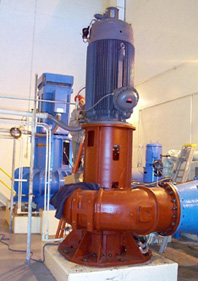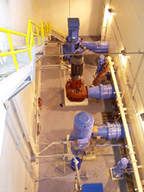Reclamation Pump Project
Sewage pumps replaced after 35 years of continuous service.
November 16, 2001
|
“We’ve really got our money’s worth,” says Water Reclamation Manager Jon Adams referring to the pumps. “The wear and tear on the pumps over the years has reduced the pump housing walls to near paper thin.” This problem has been overcome by welding additional metal to the pump housings, but for this reason, and other reasons the pumps are being replaced. At an average of about 37 million gallons per day for 36 continuous years, nearly 500 billion gallons of water has been pumped.
The pump replacement project includes two other upgrades:
- Upgrading the electric system, power transmission lines and installing variable frequency drives (VFDs), which run the massive raw sewage pumps. This project was completed last year.
- Construction of a new 48” force main to transport sewage from the pump plant to the main plant. This will increase the amount of flow, which can be pumped to the main plant; but more importantly, the additional force main will provide much needed redundancy. Currently the existing force mains are running at capacity and with the third force main, they can be taken out of service for maintenance and inspection activities. This project is in the design phase and will be constructed in the spring of 2002.
The replacement of the original (1965) raw sewage pumps increases the quantity of wastewater pumped to the main plant. Besides upgrading the pumps and increasing pumping capacity, the project ensures reliability of the pump station if a catastrophic event occurs. The original pumps are located in a bay that could be flooded in the event of an earthquake. Salt Lake City is located in an active earthquake zone, so the potential for a magnitude 7.5 earthquake is possible. A unique feature of the new pumps is that they can be operated in submerged conditions for at least 60 continuous days. While they are not classified as “submersible” pumps, they are rated as “immersible” pumps. This feature would prove to be invaluable if the pump bay was flooded due to a seismic event.
Currently, there are two 250 horsepower pumps and two 350 horsepower pumps lifting flow to the main plant. The total pumping capability of the existing pumps is 96.5 million gallons per day. These pumps will be replaced with four 350 horsepower pumps rated at 24,500 gallons per minute each, or a combined pumping capacity of 140 million gallons per day.
The increased pumping capacity provides many benefits for plant operations and maintenance requirements, such as preventing the sewage from backing up into the collection system during high water events. Also, the pumps will operate at a level of higher efficiency than the original 1965 pumps.
The second aspect of the project deals with replacement of the grit removal pumps, which remove grit or other inorganics before the wastewater is pumped to the main plant. Because of the abrasive nature of grit, the new grit removal pumps will help protect the new raw sewage pumps and force mains from excessive or premature wear. Another benefit is that the old grit piping was buried over 40 feet in depth. This will bring that piping up to a more reasonable depth of 10 feet for maintenance considerations. It also provides for greater worker safety by eliminating restricted work areas.
|
“Over the past number of years there have been numerous improvements to the Water Reclamation Plant, but none have been as important as this project,” notes Adams. “With the new 48-inch force main completed, conveying the wastewater from the collection system to the treatment plant will be ensured for years to come.”
The $967,000 pump replacement project will be completed this year. The force main will be completed next summer.

